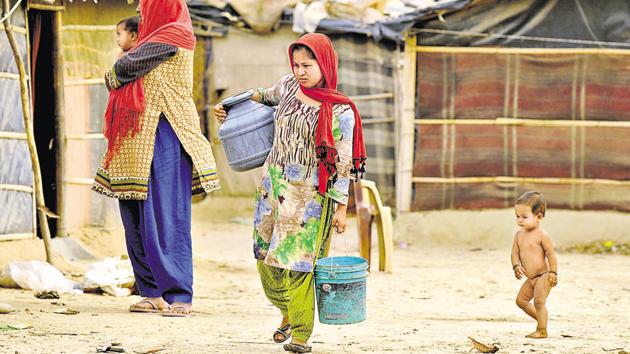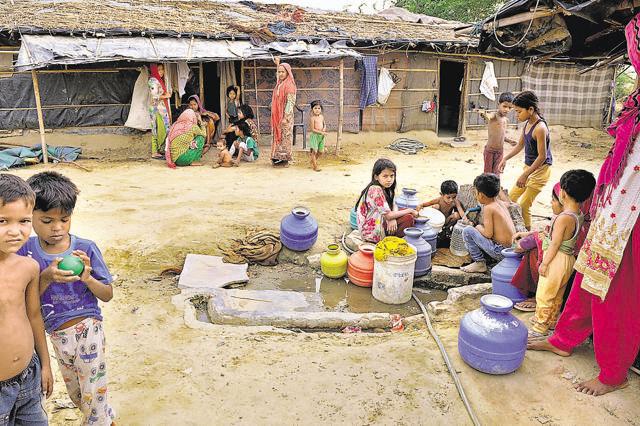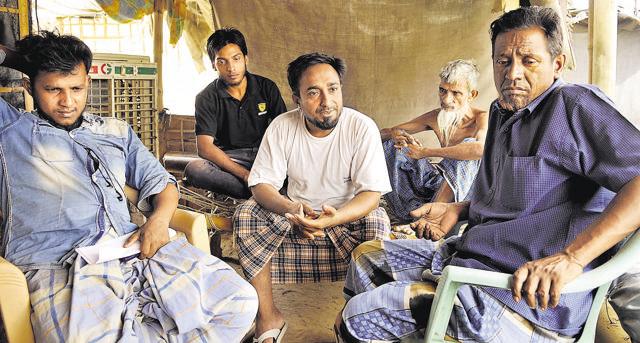They fled violence in Myanmar but Rohingya refugees living in pathetic conditions in Mewat refugee camps
In the run up to the World Refugee Day on June 20, Hindustan Times visited seven camps spread across Mewat — three in Chandeni, two in Nangli, one in Jogipur ward-7 and one in Punhana.
Dressed in a pale yellow salwar kameez, Rehana Biwi aimlessly sits at the entrance of her hutment in Jogipur ward 7 in Mewat. Rehana quickly disappears inside the house when she sees her husband approaching. The 30-year-old Rohingya refugee moved to Mewat in 2012 after undertaking an arduous journey from Myanmar. Last year in June, she lost her child during delivery at the civil hospital in Nalhar.

Last year, three cases of infant deaths were reported in Jogipur camp alone, as per residents. The lot of the refugees in other camps across Mewat, which is home to seven Rohingya settlements, is not good either.
In April this year, the Supreme Court asked the Centre to file a report about the facilities that were being provided to Rohingya refugees in Delhi and Haryana. Responding to the apex Court, the government said Rohingya refugees were not being discriminated against and all health, sanitation, medical and educational facilities were being provided to them.
In the run up to the World Refugee Day on June 20, HT visited seven camps spread across Mewat — three in Chandeni, two in Nangli, one in Jogipur ward-7 and one in Punhana — where 1294 refugees live, as per UNHCR.
Chandeni camp 1
A short detour from the Gurgaon-alwar Road via vast swathes of empty fields leads to the village of Chandeni. More than 46 km away from Gurugram, Chandeni is home to three Rohingya camps. Most of the local residents identify the camps where “baahar se aaye hue log” (outsiders) live.
Last month, a fire damaged 57 dwellings in Chandeni camp 1. A dead tree stands amid heaps of ash and dust where the camp once stood. “I was in the mosque with muezzin sahib when I saw smoke emanating from somewhere. Fire had engulfed the camp. We couldn’t do anything. By the time the fire tenders came, everything was over,” says the imam of the mosque which was destroyed along with houses.
Most refugees had been living in temporary tents provided by the district administration until a dust storm brought them down. The village panchayat has agreed to provide the land to rebuild their houses but the issue is mired in delays with another family from the village claiming the land.
Mohd. Jawed, 34, was among those who lost all their belongings in the fire. “I lost all the documents that established my identity in India. Three lakh in cash which I had saved over the years also perished. We didn’t have any bank account. We don’t know when the houses will be made again. It can take days or even months,” says Jawed.
Jawed and his wife are now trying to build a temporary hut before the monsoon sets in. “This time we were thinking of celebrating Eid by using our savings. But, fate had this tragedy in store for us,” says Jawed’s wife Sabekun Nahar.
Chandeni camp 2
Mohammad Hussain, 45, runs a small tea shop in the camp. Back home in Myanmar, he had a big shop. Hussain left Buthidaung in Myanmar in 2012.
“Buddhists nationalists started killing us. Our sons were dragged out of the house and women assaulted. They burnt down our houses,” Hussain says.
Hussain’s brother is in Bangladesh. He has no contact with him. “We lost each other while trying to flee from Myanmar. There was chaos all around. I left in one boat, he took another one. An acquaintance who came from Bangladesh told me about my brother,” he says. Hussain made a perilous journey from Myanmar to Bangladesh and then to Kolkata. He lived in Jammu for a few days after which he set out for Mewat.
“We were scared. We found that Muslims lived in Mewat and, therefore, we moved here,” he says.
The families in Chandeni 2 contribute to pay ?35,000 per year as rent for the plot of land where they have made their dwellings. “We save a little to pay for the rent. Sometimes, it gets difficult since there are not enough work opportunities in Mewat. Most people look for odd jobs,” says Hussain. At this point, the tungsten bulb that lights the hut goes out.
“The power is irregular and so is water supply,” says Hussain as he passes a cup of tea to a local villager, Nisar Ahmad. Ahmad works in the local post office in Mewat.
“The court will decide the fate of the refugees but we have no issues with them. They are kind people. The area is safe for them but they have no work to do,” says Ahmad.
Children in this camp go to a nearby school in Ferozpur Namak. Rashida, 11, walks to her school every day. “I like to study. Hindi is my favourite subject. I want to become a madam (teacher) when I grow up,” says Rashida, who has been living in the camp for the past four years.
Nur Begum, 50, has been living in the camp with her two sons, a daughter-inlaw and grand-children for the past four years. Cardboards supported by bamboo sticks and covered with black tarpaulin make up Nur’s modest shanty. Nur’s husband and one-year-old infant were killed in the violence which broke out in 2012 in her village in Buthidaung, Rakhine district.
“I can’t forget that day. Dilbar was sleeping post asar (afternoon) namaz. Our roof was made of leaves which caught fire easily and fell on him. I woke him up and dragged him out. In the melee, I couldn’t save my younger one. My elder son, Ramzan, was stabbed,” mutters Nur in between sobs.
Nur’s 22-year-old son Dilbar Hussain, then an 18-year-old, sustained burns when a portion of the ceiling fell on him. Dilbar works as a labourer occasionally.
Dilbar’s elder brother Ramzan isn’t of much help since his injury makes it difficult for him to walk. Ramzan rues the limited work opportunities in Mewat. “We had a huge bamboo house until our world was destroyed. There is no work here but we don’t have a choice. My father was beheaded before my eyes,” says Ramzan.
“I miss my country and would want to go back if there is a guarantee that equal rights will be given to the Rohingyas,” he adds as an afterthought.
Nur Begum sitting in the background aggressively moves her head signalling disapproval. “We will never go back. There’s no way we are going to that place, no matter what happens. Kill us here if you have to,” says Nur.

Chandeni camp-3
Nur Hassan moved to Mewat from Mathura six months ago. Soon after arriving in India, he, along with others was allegedly sold by middlemen as bonded labour and moved to Mathura. “Someone in the rag-picking business took us there. We would collect garbage and half of our daily earnings would be taken by them. We were under debt and didn’t know what to do. There was no place to live, no place where we could educate our children. The police drove us away one day,” says Hassan.
Hassan takes us on a tour of the camp to show the pathetic conditions. “We have requested the UN to do something about the situation but our pleas have fallen on deaf ears. Our kids are falling sick. We do not have proper toilets,” says Hassan.
Besides toilets, lack of clean drinking water is a common problem across the camps. Residents shell out ?600 for a tanker of water every day. Water from the tanker is collected in a reservoir to be used for drinking and washing. “The water is not clean. Rainwater gets mixed with the water. There are insects too but we don’t have a choice,” says Hassan.
Hassan’s mother and siblings are in Myanmar. “I call them after every 3-4 months but don’t ask them anything about the conflict. They may land in trouble if someone gets to know about it,” says Hassan.
Jogipur Ward-7
Dressed in a tamain, a traditional Burmese wrap-around skirt, 30-year-old Asma is busy sewing an orange dress. Her feet are placed on the pedal of the sewing machine as her husband and mother sit behind her.
“Back in Burma, my husband used to operate a boat. We had two boats and lived in a pucca house,” she says while remembering her time in Myanmar.
She has a 14-year-old son named Fayazul Islam and 13-year-old daughter Kaheena Akhtar. Her son walks an hour every day to attend a school few kilometres away. Her daughter had studied till Class 3 before she dropped out.
Mohammad Alam and some others are sitting outside since there is no power. Alam came to India via the Bangladesh border in 2014. On reaching India, he was allegedly attacked by some people in Balurghat, West Bengal. When Alam and his family resisted, they were handed over to the police. “I stayed in the prison for five months 17 days. My child was taken away and put in another place. Somehow, I managed to call my brother who came to our help,” says Alam.
There are 90 families in the camp with 270 people, said Zaibul Alam, 26, who is the ‘zimmedar’ (incharge) for Jogipur Ward 7 camp. However, as per UNHCR partner agency, there are 301 residents.
Children in the camp used to go to the nearby Chaudhary Mohd. Yasin Khan Meo Senior secondary school till three months ago but had to drop out after the school became private. “We barely earn enough to feed our children. How can we send them to school? We cannot afford the fees now,” says Alam.
Kavita Agarwal, principal of Chaudhary Mohd. Yasin Khan Meo Senior secondary school said refugee children had started dropping out of the school over the past few months. “Earlier, around 40 refugee children would study in our school for as little as ?50. Now the school has become private. The Rohingya children started dropping out gradually and at present no Rohingya child studies here,” says Agarwal.

Nangli Camp 1 and 2
Mohd Ayaz, 40, holds two white plastic packets as we follow him to his house. He has just returned from the neighborhood market. His son Mohd Suenoor greets him at the door. Ayaz lays down the packets on the sofa and unpacks them. He spreads out a navy-blue T-shirt, two pairs of jeans and a pair of shoes.
Recollecting Eid festivities back home, Ayaz said, “Back home, my mother and sister used to wake up at the crack of dawn and start cooking. We would offer namaz and make dua for the deceased. Over here, there is hardly any celebration. Our lives revolve around the everyday troubles of arranging for food and water.”
Noor Alam, 47, is the zimmedar (in charge) for Nangli 2 camp. The camp houses 90 families of 330 refugees. However as per UNHCR there are 326 of them. The camp has reported three fire incidents. Two-three months back, four houses in the camp had caught fire and a makeshift mosque was burnt down more than a year back. In another accident, a 60-year-old had died.
Refugees here pay ?600 per tanker for drinking water. For bathing and washing, they use water from a well. There are no proper toilets. Earlier, a teacher from a non-profit organisation would come to teach the children in the camp. However, no teacher has been coming for the past one year, say residents.
Despite being fearful of the circumstances back home, Alam hopes to go back one day. “Who would want to leave one’s own country? Even birds don’t want to leave their houses. Back in Burma, I had a two-floor house. Who wants to stay in a house of plastic?” asks Alam.
Punhana camp
Rehana Akhtar, a resident of the Rohingya refugee camp in Punhana village in Mewat, about 86 km away from Gurugram, complains about the lack of toilets and the consequent spread of diseases . “There are insects all around due to which all the children are always falling sick,” she said.
Rehana doesn’t have a toilet inside her home. She doesn’t want her child to fall sick and goes out in the open to defecate. There are two makeshift toilets in the camp for men but none for women.
Around 5 in the morning, she wakes up, wears her burqa and heads to the nearby forest. “We are living in heat, dust, illness but still find India better than Burma. Shouldn’t this make people realize how bad the situation in Burma is?” she asks.
Fatima, another resident, says her family left Myanmar to escape the violence. “We were forced to leave Burma because of communal tensions. Buddhists told us that Burma was not our country and we didn’t have any right to stay there. Over here, the plot owner wants us to leave the place. Where do we go? Our life is perennially in transit,” says 17-year-old Fatima.
Court intervention
The Supreme Court on May 11 designated local sub-divisional magistrates as nodal officers to address concerns about healthcare, food, sanitation and education of Rohingya refugees living in camps in Haryana and Delhi.
“Refugee camps are spread across twothree sites in Mewat. Basic facilities like water, electricity and bedding are provided by the government,” says Priti, who took charge as SDM of Mewat on June 4. She prefers to go by her first name only.
“We provided tents, mobile toilets and food for a few days in Chandeni camp 1 but they were destroyed in a fire. They have pucca toilets which were not working for some time but we got them fixed. Electricity and water facilities are available to residents in other camps as well,” says Sher Singh, Naib Tehsildar of Nuh.
Khurshid Rajaka, chairman of the Mewat Development Agency, a government welfare body constituted in 1980, says, “These camps existed here before the current government came to power. They live on plots that have been given by villagers or some vacant plots. They manage their affairs themselves. The Haryana government is not providing any facilities in the camps”
Organisations that work for the welfare of the refugees say water and education are a major problem area.
“The Haryana government provided water tankers in the camps during the summers or the recently concluded Ramzan but not throughout the year. It’s becoming difficult to get children enrolled in schools since the state government doesn’t give admission without Aadhar card. As far as sanitation is concerned, the centre’s report submitted to the SC was silent on the issue of toilets. Refugees are not covered under the Swachh Bharat Abhiyan,” says Ravi Hemadri, director of the Development and Justice Initiative, UNHCR’S implementing partner in Haryana.



